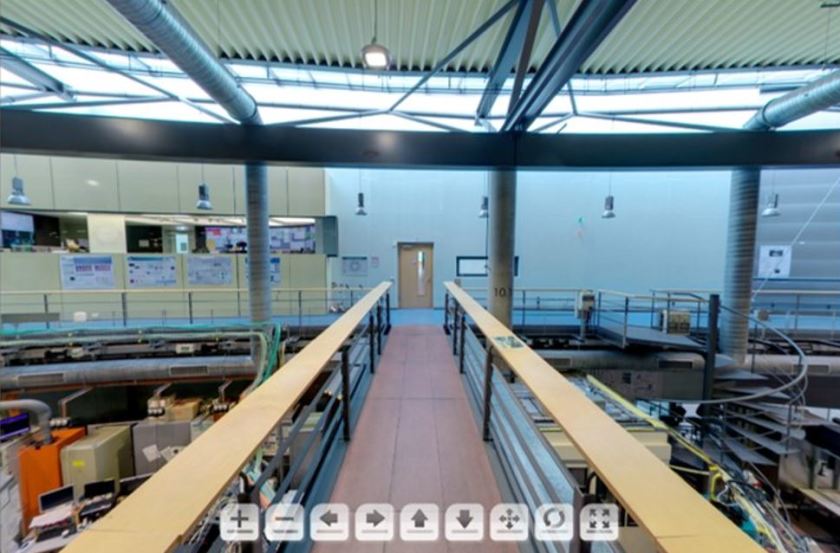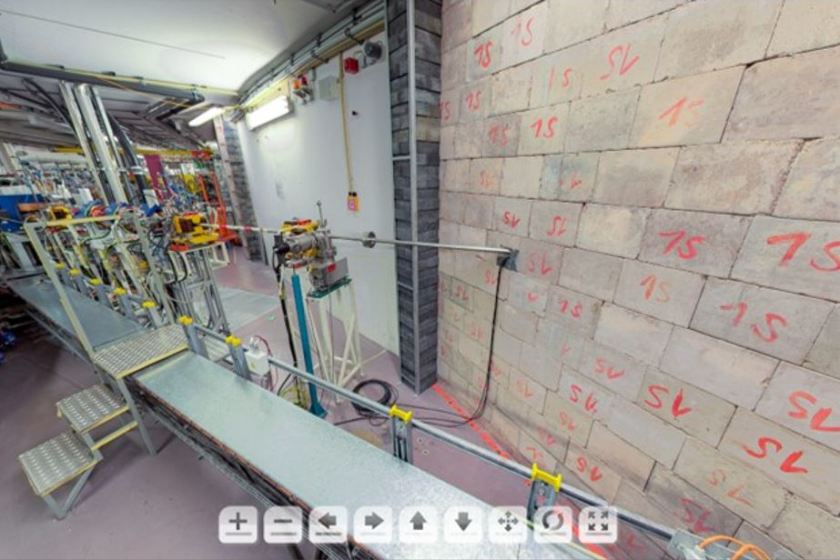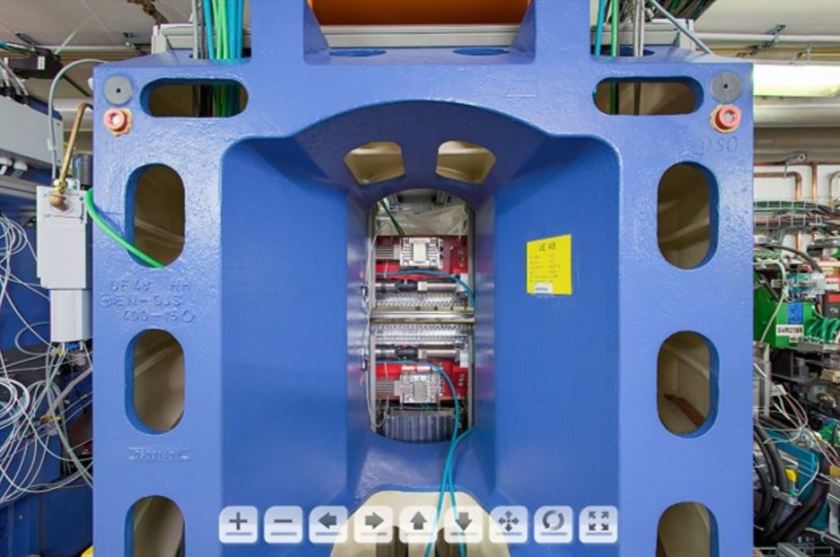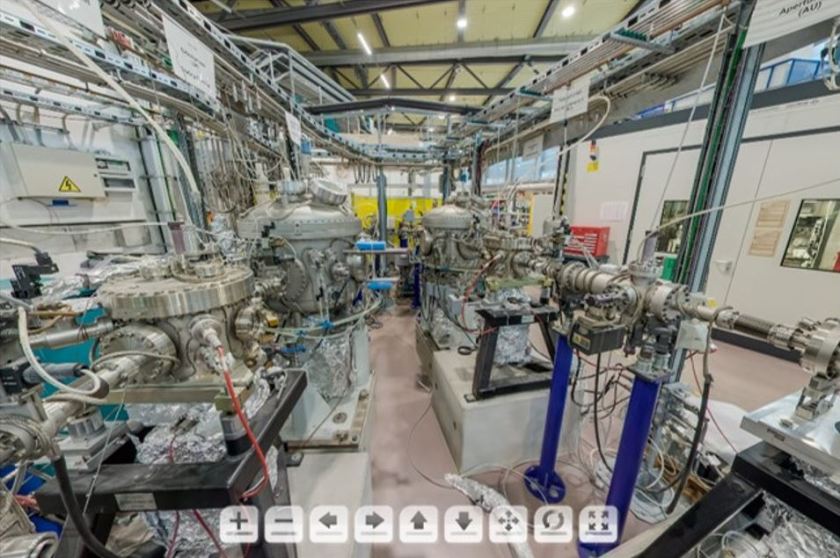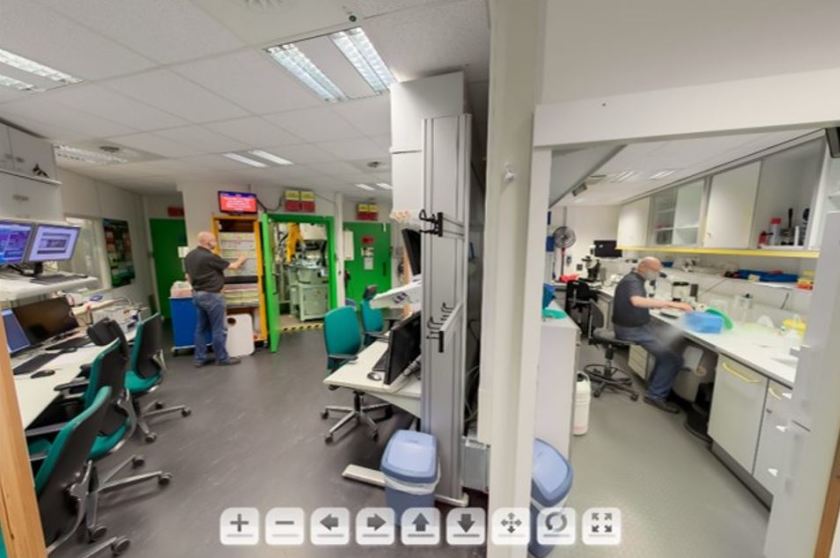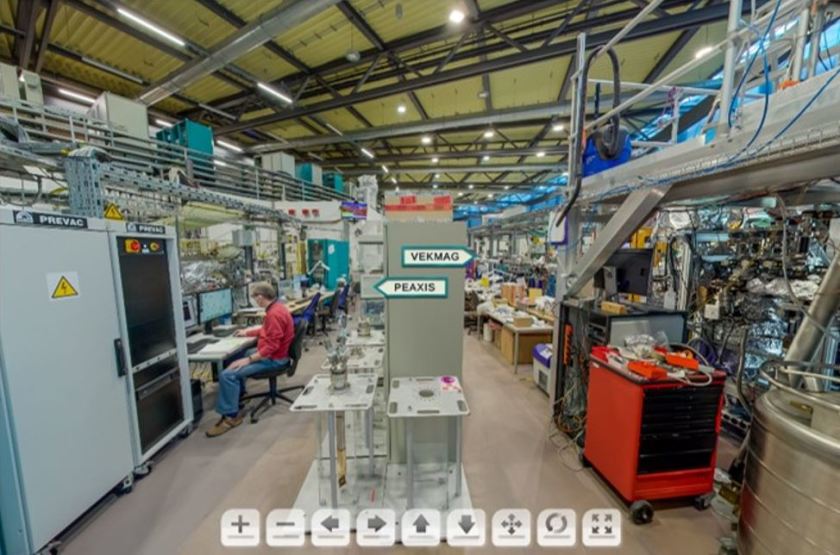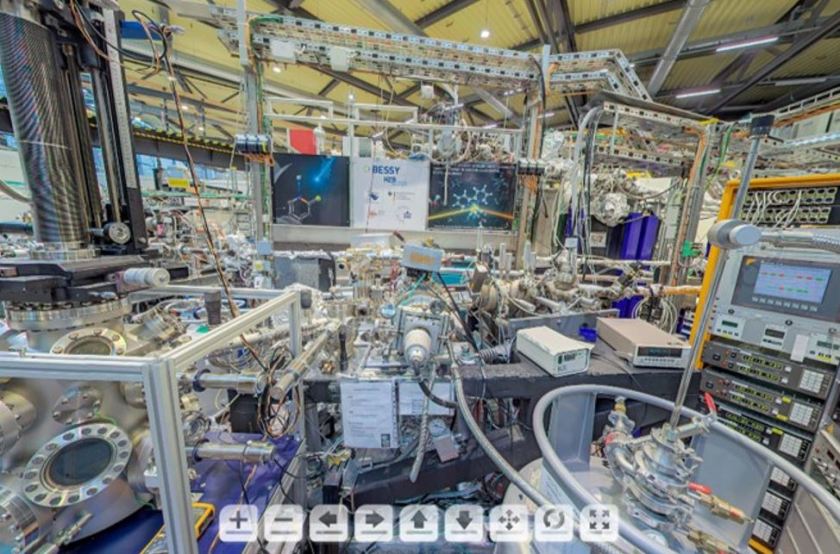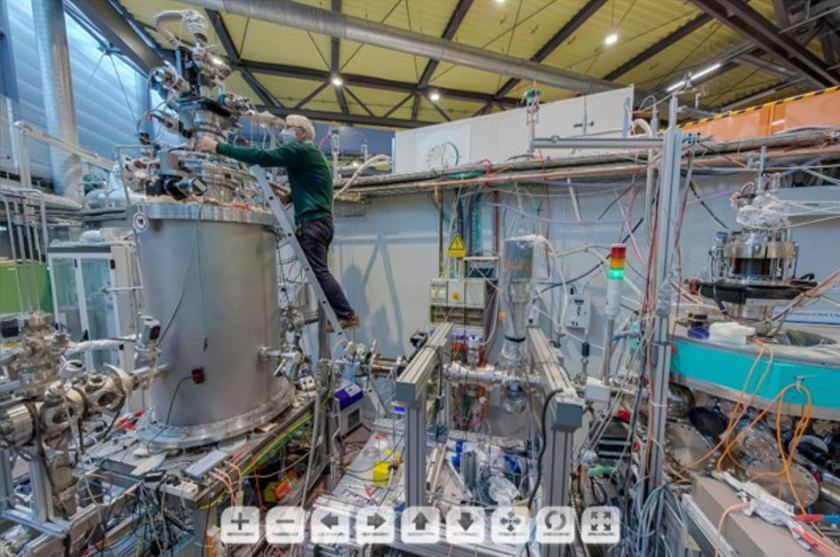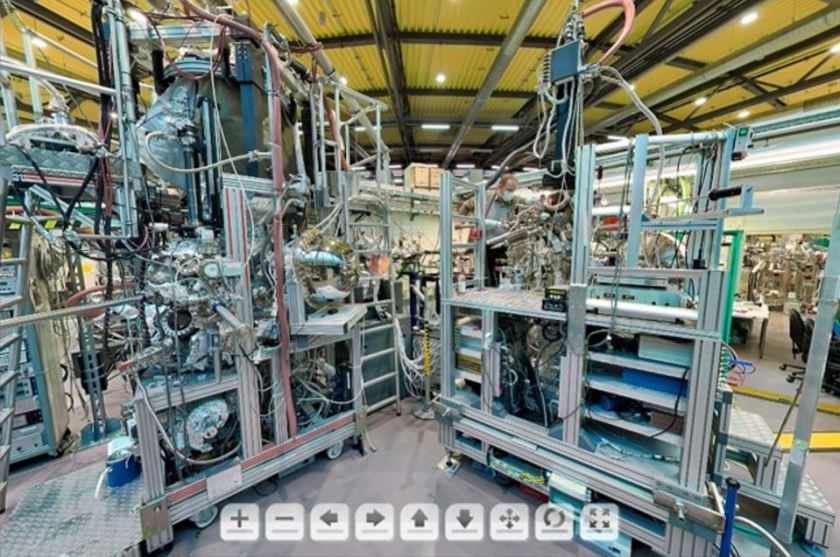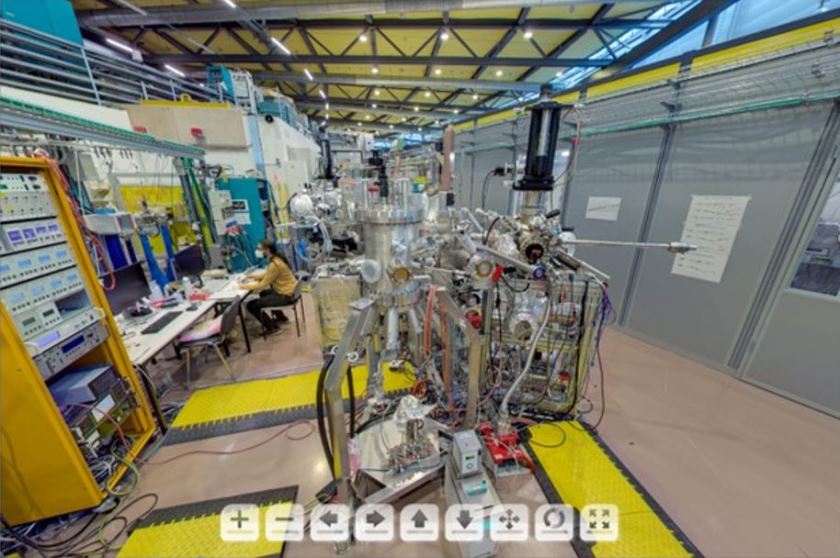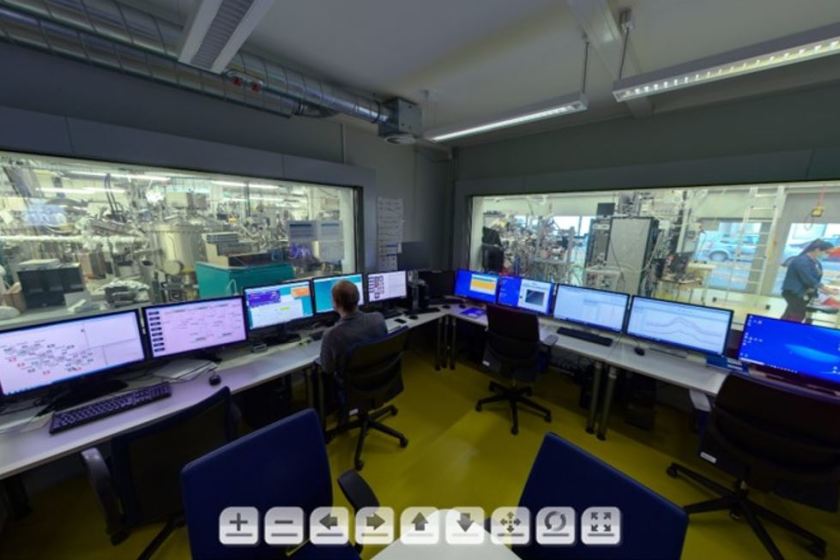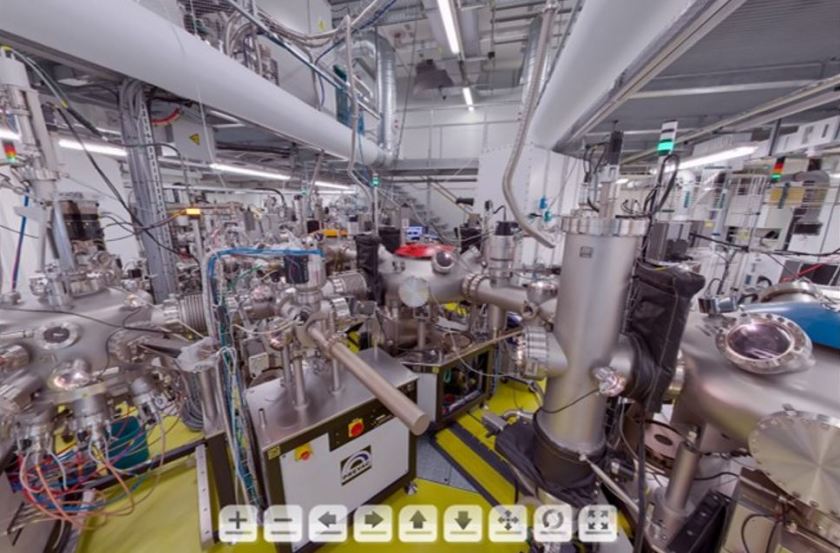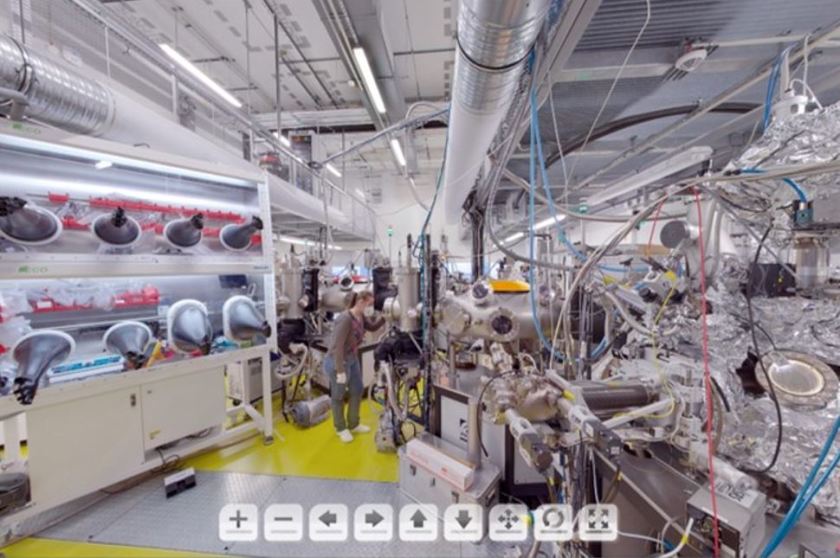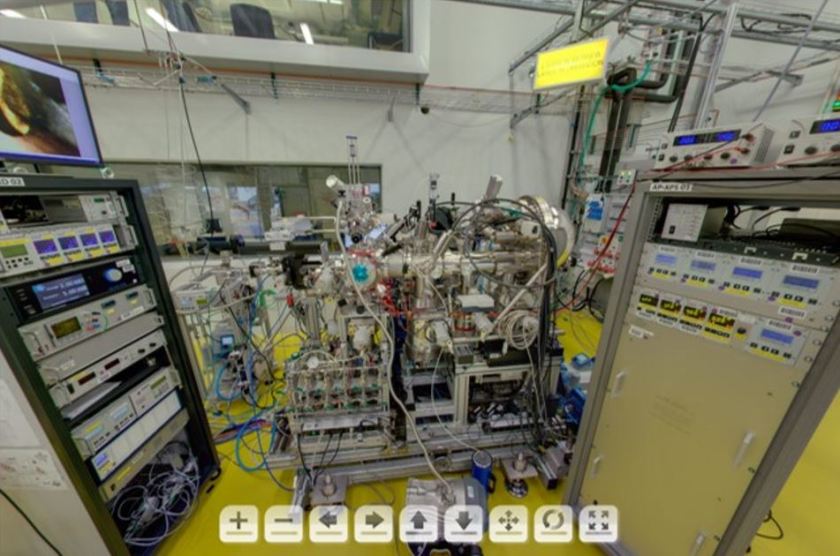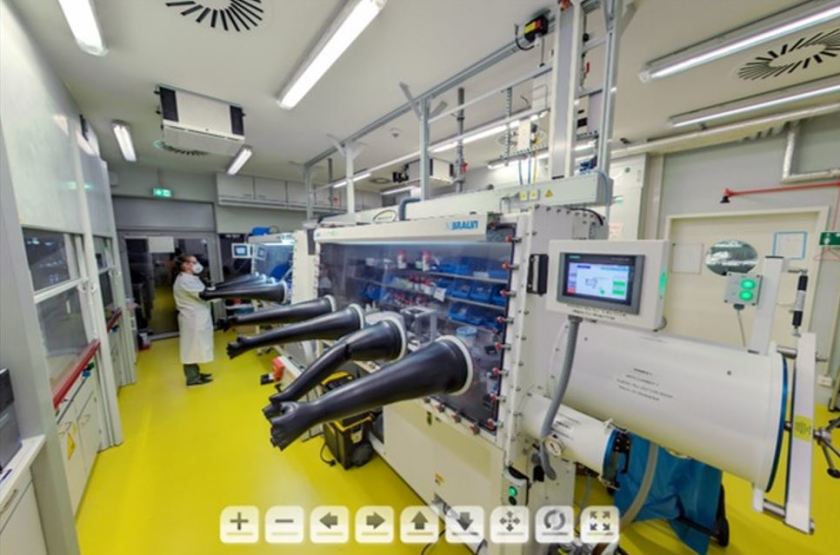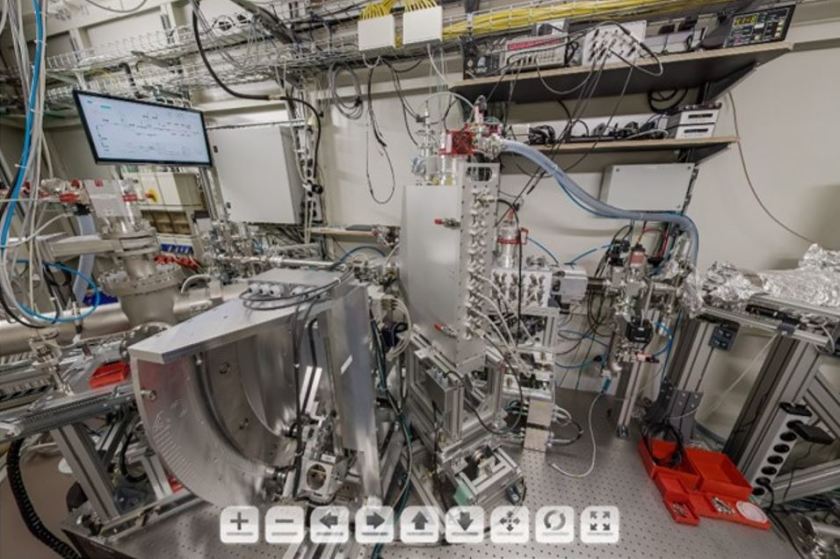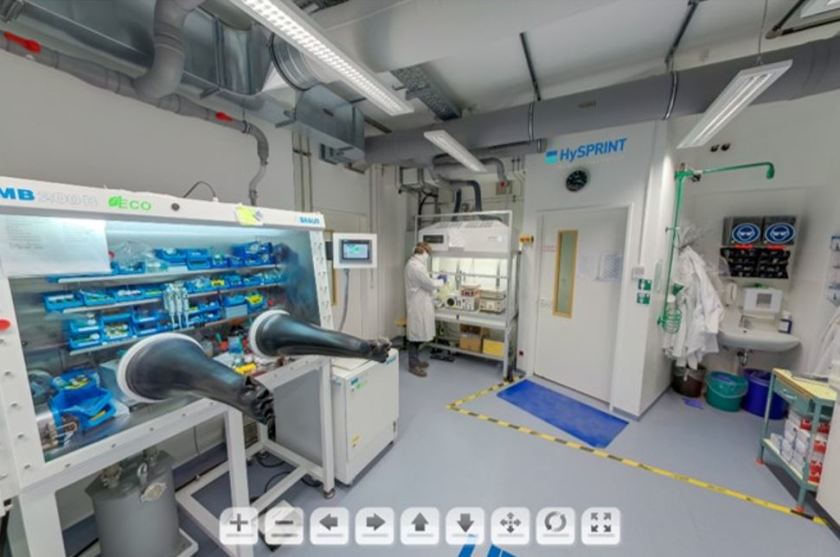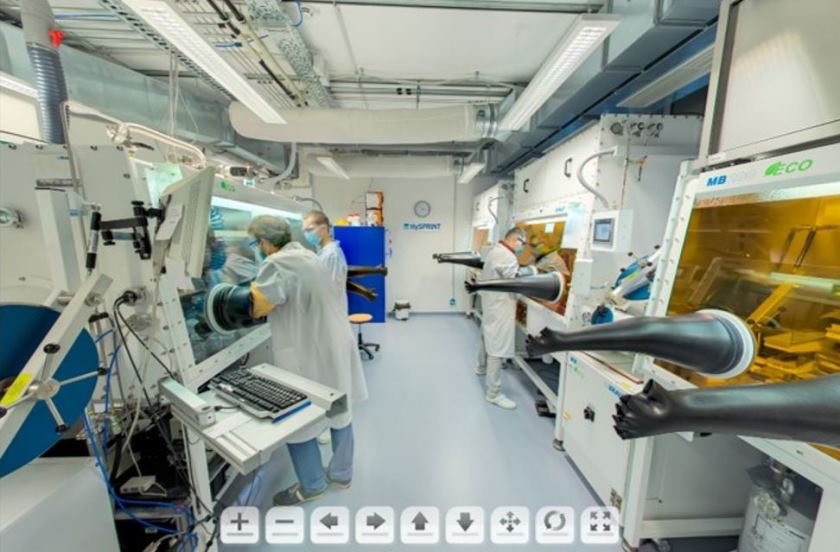360-Degree Panoramas
Some of the HZB's research facilities can be visited as 360-degree panoramas. These panoramas do not contain any explanations and are mainly available to our researchers and cooperation partners for guided tours or lectures.
Are you interested in how research at our accelerator facility BESSY II works? Then take an interactive tour of our research here.
24 Panoramas for viewing
1) Panoramas of the electron storage ring BESSY II
Control Room BESSY II and MLS
Control Room BESSY II (HZB) and MLS (PTB)
BESSY II is an electron storage ring that produces extremely bright light for research purposes. In the control room, the quality of the beam is monitored 24/7 and adjusted, if necessary.
Bridge – Control Room
Bridge – Control Room (Experimental Hall of BESSY II)
Inside the experimental hall of BESSY II you can see several beamlines with experimental stations. Some of them are inside experimental hutches.
Bridge – Truck Lock
Bridge – Truck Lock (Experimental Hall of BESSY II)
Inside the experimental hall of BESSY II you can see several beamlines with experimental stations. Some of them are inside experimental hutches.
Synchrotron
At BESSY II, an electron source generates electrons that are pre-accelerated to near light speed. They are then fed into the storage ring. In order to guarantee consistently high beam quality, the ring is regularly topped up with new electron bunches.
Storage Ring
Various components are installed along the storage ring in a circular arrangement. Numerous focusing and diversion magnets lead the particles onto the right flight path. As the electrons fly by certain magnetic arrangements (undulators), they are forced into a slalom course. When they do this, the electrons give off energy in the form of electromagnetic radiation. This synchrotron radiation is redirected through beam tubes to the various experimental stations, where researchers can use it for their experiments.
Undulator inside the storage ring tunnel
Undulator inside the storage ring tunnel
An undulator consists of a sequence of magnets (permanent or electromagnets) whose north and south poles are arranged opposite each other in regular repetition. This special arrangement of magnets causes the electrons to follow an undulating path.
Berlin Joint Lab for Electrochemical Interfaces - BElChem (MPG endstation)
Berlin Joint Lab for Electrochemical Interfaces - BElChem (MPG endstation)
BElChem employs X-rays from BESSY II to analyse functional materials for renewable energy production and materials for electrochemical and catalytic applications.
Beamlines of the Max-Planck-Gesellschaft on UE56/2
Beamlines of the Max-Planck-Gesellschaft on UE56/2
Plane grating monochromator beamlines served by the elliptical undulator UE56/2 that deliver soft X-rays of variable polarisation in the energy range of 90eV – 1200eV to the BElChem AP-XPS spectrometer.
Inside the MX Hutch
Inside the MX Hutch (Macromolecular Crystallography)
The infrastructure adjacent to the experimental end stations offers excellent facilities for users of the beamlines and includes office space, a sample preparation lab, a biology lab (safety level 1), and computing resources.
Experimental Stations PEAXIS and VEKMAG
Experimental Stations PEAXIS and VEKMAG
PEAXIS (Photo Electron Analysis and X-ray Inelastic Spectroscopy) is a fixed station installed at the U41-PEAXIS beamline. It is dedicated to soft X-ray spectroscopy studies on the electronic structure of novel quantum materials. PEAXIS offers capabilities for soft X-ray Resonant Inelastic X-ray Scattering (RIXS) and Photo Electron Spectroscopy (PES) on bulk and thin-film solid state samples. RIXS in particular can be used to study the local electronic structure at element- and orbital-specific atomic sites and yields wavevector-resolved information about dynamics of collective excitations.
VEKMAG is a Vector Superconducting Magnet station jointly developed by Regensburg University, Free University Berlin, Ruhr University Bochum, and Helmholtz-Zentrum Berlin. The instrument is designed for XAS/XMCD measurements, for resonant and off-resonant soft X-ray magnetic scattering methods, as well as for time-resolved ferromagnetic resonance using XMCD, in high magnetic fields up to 9 Tesla and for a temperature range of < 2 K - 500 K.
SPEEM - Spin resolved Photoemission Microscope
SPEEM - Spin resolved Photoemission Microscope
SPEEM was developed for the investigation of Spintronic devices on a sub-100 nm scale and is based on a photoemission electron microscope installed at a dedicated microfocus beam line with full polarization control. The combination of microscopy and polarization control of the synchrotron radiation offers ideal possibilities for the spatially resolved and element-specific investigation of nanostructures by means of chemical maps (XAS) and magnetic imaging (XMCD and XLD).
Beamline UE 46_PGM-1
UE46_PGM-1 is one of two beamlines situated at the elliptical undulator UE46 and hosts two permanent endstations, the XUV Diffractometer, an instrument dedicated to high performance RSXS studies and the High-field Diffractometer, an instrument for RSXS and XAS studies in magnetic fields up to 7 Tesla. Both instruments can be used within the same beam time.
ARPES 12 and ARPES 13
The 13 and 12 stations for angle-resolved photoemission spectroscopy (ARPES) are operated in collaboration with the IFW Dresden and are permanently attached to a dedicated plane grating monochromator beamline (PGM2). The main difference between the 12 and 13 ARPES setups is the lowest achievable sample temperature: 12 offers a temperature range from –260 °C up to room temperature, allowing for a wide range of applications. 13 reaches a uniquely low sample temperature of only one degree above the absolute minimum of -273.15 °C.
Joint Lab Functional Quantum Materials (IFW Dresden)
Joint Lab Functional Quantum Materials (IFW Dresden)
A central infrastructure of the lab, a molecular beam epitaxy (MBE) machine combined with ARPES, is settled in the UE112 beamline environment. It is dedicated to explore new materials with promising quantum properties for future applications, for instance in information technologies. The scientists will further develop the common instrumentation at BESSY II with its unique properties - part of them without rival in the world. With the joint lab, IFW Dresden and HZB intensify their collaboration in research and the promotion of young scientists.
ENERGIZE - the photoelectron spectroscopy beamline for energy materials
ENERGIZE - the photoelectron spectroscopy beamline for energy materials
ENERGIZE is a collaboration of Helmholtz-Zentrum Berlin and the Integrative Research Institute for the Sciences Adlershof (IRIS) of Humboldt Universität zu Berlin. The goal of this project is to build and operate a beamline with an end-station that is optimized for materials’ electronic structure research. ENERGIZE will be dedicated to users working on electronic and energy materials, towards energy efficient technologies. The beamline is expected to be commissioned in 2021.
2) Panoramas of EMIL - Energy Materials In-Situ Laboratory Berlin
One part of this new multi-user platform is the unique large-scale project EMIL (Energy Materials In-situ Laboratory) located at the synchrotron radiation source BESSY II. EMIL combines soft, tender and hard x-ray spectroscopic methods with a variety of synthesizing, preparation and characterization methods and allows both simultaneous in-situ and operando measurements at several different stations.
EMIL, Control Room
In the control room, the quality of the beam at the CAT Laboratory and at the SISSY Laboratory is monitored and adjusted, if necessary.
SISSY Laboratory_1
A major feature of the SISSY-Lab is the direct (i.e., under ultra-high vacuum [UHV] conditions) connection of industry-relevant deposition methods to synchrotron- and lab-based X-ray characterization tools via a fully automatized UHV-transfer backbone. By this arrangement, the growth of a material and/or the formation of a device-relevant layer stack can be analyzed in-system step by step. Special precautions regarding cross-contamination even allow the preparation and study of different material classes in one combined synthesis/analysis system.
SISSY Laboratory_2
A major feature of the SISSY-Lab is the direct (i.e., under ultra-high vacuum [UHV] conditions) connection of industry-relevant deposition methods to synchrotron- and lab-based X-ray characterization tools via a fully automatized UHV-transfer backbone. By this arrangement, the growth of a material and/or the formation of a device-relevant layer stack can be analyzed in-system step by step. Special precautions regarding cross-contamination even allow the preparation and study of different material classes in one combined synthesis/analysis system.
CAT Laboratory
The CAT laboratory is devoted to research on catalysts and catalytic reactions under ambient pressure conditions. The scientific aim is to study the electronic surface/near surface structure of functional materials in the presence of a reactive environment. This includes both gas/solid interfaces (e.g. heterogeneous catalysis) and liquid/solid interfaces (e.g. catalytic water splitting).
CAT@EMIL is operated by research groups of the Fritz-Haber-Institut der Max-Planck-Gesellschaft (Berlin) and the Max-Planck-Institute for Chemical Energy Conversion (Mülheim a. d. Ruhr).
Chemistry Laboratory
The chemistry laboratory at EMIL is fully equipped and allows for standard chemical procedures. The available inert-gas purged gloveboxes can be used to prepare/handle air-sensitive samples.
EMIL Optics Hutch
The EMIL optics hutch contains the most important parts of the beamlines: Here are three monochromators installed, which select a defined part out of the huge available energy range of 80 eV up to 10 keV generated by two undulators. Furthermore, several switching mirror units ensure that the light goes to the selected endstations. Through the possibility that two light sources (U17, UE48) can feed up to five endstations (SISSY-I, SISSY-II, CAT, PINK, STXM) this hutch is like a labyrinth of tubes, pumps and chambers with high precision optics.
PINK
The PINK setup is designed to operate in the tender x-rays regime with energies ranging from 2 to 10 keV. This unique energy range provides access to both non-resonant and resonant XES studies of transition metals ranging from Ti to Cu (Kα, Kβ lines) and Zr to Ag (Lα, Lβ lines), as well as lighter elements including P, S, Cl, K, Ca (Kα, Kβ lines). The PINK setup is fixed on the motorized platform and incorporates beam diagnostic elements, two energy dispersive von Hamos spectrometers equipped with area detectors, a cryo-cooled sample environment chamber, and other electronics and vacuum equipment.
3) Panoramas of HySPRINT
The Helmholtz Innovation Lab HySPRINT is a cooperation platform for industry at Helmholtz-Zentrum Berlin with a focus on (opto)electronic materials and devices at an early technological stage of development.
Perovskite Laboratory (Preparation)
HySPRINT - Perovskite Laboratory (Preparation)
Perovskite Laboratory
HySPRINT - Perovskite Laboratory
The perovskite lab is fully equipped to enable the realization of highly efficient perovskite single junctions and tandem solar cells as well as its components.


